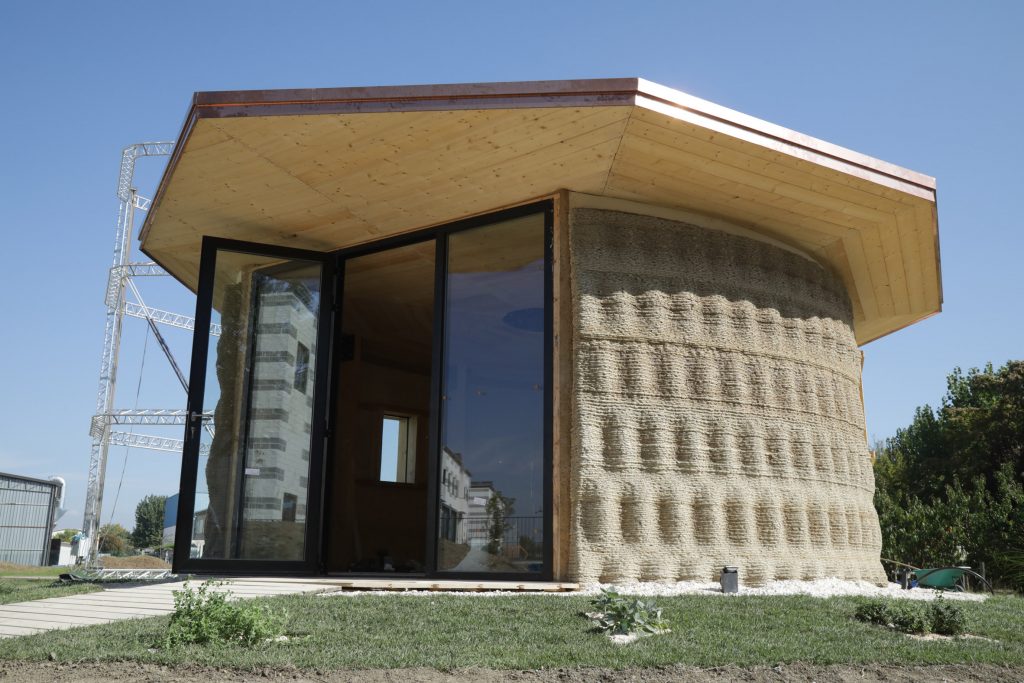We’ve have been following WASP for years, along with keeping tabs on progress at the village of Shamballa, a small and extremely progressive Italian community featuring homes fabricated with impressive, large-scale 3D printers. If you want a glimpse into what can be expected, look at Gaia, a model with an outer shell and beams constructed from organic material like soil and agricultural waste. The home measures 30 square meters (just over 320 square feet) and is on site at Massa Lombardo, at Shamballa, in the Emilia-Romagna region of Italy.
Although 3D printing has been a tremendous boon to myriad industries manufacturing parts and prototypes created from an ever-expanding range of plastics and metals, many users have delved deep into the study of material sciences—and ways to use the technology that are environmentally friendly. The 3D printing materials for Gaia were created from a biodegradable recipe of mud at the Shamballa site, plus waste from rice farming like straw and husks used for their natural insulating qualities.
“Gaia is the result of a limited and optimized use of agricultural resources, which through technology have been converted into a complex building with a minimal environmental footprint,” the WASP development team explained in a recent interview.
“If the building isn’t maintained, it will turn back into soil,” said WASP regarding the small home.
The technique and resourcefulness used in this project demonstrate the potential for diversified materials usage in 3D printing and construction overall; in fact, waste materials from a widely produced commodity like rice can be turned into insulation so effective that it may reduce or eliminate the use of other heating methods during the colder months in Italy.
“It is possible to conceive a future scenario in which one hectare of cultivated paddy field can become 100 square-meters of built environment,” WASP said.
Empty pockets are created within the walls allowing for ventilation and efficiency overall. Husks were also used in the roofing materials for further warmth and protection. The most intrinsic benefits of 3D printing in construction are on display with this model home that cost less than a thousand pounds to make and was completed in only ten days. And while the benefit of ‘making less waste’ is highly touted, here the team is using waste; also, the WASP team believes numerous other natural waste materials could become useful in construction around the world.
“Gaia is a highly performing structure in terms of energy, with almost no environmental impact,” said the WASP development team.
3D printing in construction is a topic that gets builders, developers, and consumers at every level excited because of the true potential it has for changing nearly every process of the building and even selling process; in fact, in some cases, building a home via 3D printing may become an inexpensive DIY process leading not only to opportunities to anyone with the wherewithal to assemble a small construction, but also continuing to add to options for developing countries and areas in need of housing during disaster relief. Builders today have already used 3D printing for off-the-grid smart homes, tiny homes, pods, and other protective structures, even including bus stop shelters. Find out more about WASP and their ongoing 3D printing projects here.
What do you think of this news? Let us know your thoughts! Join the discussion of this and other 3D printing topics at 3DPrintBoard.com.
[Source / Video and Images: Dezeen]
Subscribe to Our Email Newsletter
Stay up-to-date on all the latest news from the 3D printing industry and receive information and offers from third party vendors.
You May Also Like
3D Printing Unpeeled: New Arkema Material for HP, Saddle and Macro MEMS
A new Arkema material for MJF is said to reduce costs per part by up to 25% and have an 85% reusability ratio. HP 3D HR PA 12 S has been...
3D Printing News Briefs, January 20, 2024: FDM, LPBF, Underwater 3D Printer, Racing, & More
We’re starting off with a process certification in today’s 3D Printing News Briefs, and then moving on to research about solute trapping, laser powder bed fusion, and then moving on...
3D Printing Webinar and Event Roundup: December 3, 2023
We’ve got plenty of events and webinars coming up for you this week! Quickparts is having a Manufacturing Roadshow, America Makes is holding a Member Town Hall, Stratafest makes two...
Formnext 2023 Day Three: Slam Dunk
I’m high—high on trade show. I’ve met numerous new faces and reconnected with old friends, creating an absolutely wonderful atmosphere. The excitement is palpable over several emerging developments. The high...




































